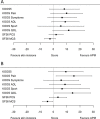Better outcome from arthroscopic partial meniscectomy than skin incisions only? A sham-controlled randomised trial in patients aged 35-55 years with knee pain and an MRI-verified meniscal tear
- PMID: 29420232
- PMCID: PMC5829931
- DOI: 10.1136/bmjopen-2017-019461
Better outcome from arthroscopic partial meniscectomy than skin incisions only? A sham-controlled randomised trial in patients aged 35-55 years with knee pain and an MRI-verified meniscal tear
Abstract
Objective: Compare arthroscopic partial meniscectomy to a true sham intervention.
Methods: Sham-controlled superiority trial performed in three county hospitals in Denmark comparing arthroscopic partial meniscectomy to skin incisions only in patients aged 35-55 years with persistent knee pain and an MRI-confirmed medial meniscus lesion. A computer-generated table of random numbers generated two comparison groups. Participants and outcome assessors were blinded to group allocation. Exclusions were locking knees, high-energy trauma or severe osteoarthritis. Outcomes were collected at baseline, 3 and 24 months. We hypothesised no difference between groups. The primary outcome was the between-group difference in change from baseline to 2 years in the mean score across all five normalised Knee injury and Osteoarthritis Outcome Score (KOOS) subscales (KOOS5).
Results: Forty-four patients (of the estimated 72) underwent randomisation; 22 in each group. Sixteen participants (36%) were non-blinded and eight participants (36%) from the sham group crossed over to the surgery group prior to the 2-year follow-up. At 2 years, both groups reported clinically relevant improvements (surgery 21.8, skin incisions only 13.6), the mean difference between groups was 8.2 in favour of surgery, which is slightly less than the cut-off of 10 prespecified to represent a clinically relevant difference; judged by the 95% CI (-3.4 to 19.8), a possibility of clinically relevant difference could not be excluded. In total, nine participants experienced 11 adverse events; six in the surgery group and three in the skin-incisions-only group.
Conclusion: We found greater improvement from arthroscopic partial meniscectomy compared with skin incisions only at 2 years, with the statistical uncertainty of the between-group difference including what could be considered clinically relevant. Because of the study being underpowered, nearly half in the sham group being non-blinded and one-third crossing over to surgery, the results cannot be generalised to the greater patient population.
Trial registration number: NCT01264991.
Keywords: adult orthopaedics; knee; musculoskeletal disorders; orthopaedic sports trauma.
© Article author(s) (or their employer(s) unless otherwise stated in the text of the article) 2018. All rights reserved. No commercial use is permitted unless otherwise expressly granted.
Conflict of interest statement
Competing interests: None declared.
Figures



References
Publication types
MeSH terms
Substances
Associated data
LinkOut - more resources
Full Text Sources
Other Literature Sources
Medical
